Browse Primary Sources
Locate primary sources, including images, objects, media, and texts. Annotations by scholars contextualize sources.

Thälmann Pioneer's Shirt
This shirt is an example of the uniforms worn by children aged 6-14 who were members of the Young Pioneers in East Germany. Founded in 1948, the Young Pioneer movement was similar to the Boy and Girl Scout movements that originated in the United Kingdom at the turn of the century and spread around the world.

Vending Machine
In the United States coin-operated drink machines - generically called "coke machines" - are ubiquitous consumer objects regularly punctuating our everyday landscapes. We feed them our money and out roll individually packaged liquid refreshments. During the last years of the Cold War designers in the East Bloc developed their own regional version of the "coke machine".
Oh Richard, Oh, My King!
This aria from the Gretry opera, Richard the Lion–Hearted, was adopted by royalists during the early years of the French Revolution. The song’s accusation that the king had been abandoned by all but his most devoted followers made it a suitable counter–revolutionary anthem.
It’ll Be Okay
Popular during the early years of the French Revolution, this song’s lively tune and repetitive chorus expressed revolutionaries’ hopefulness about the future. Singers manipulated its malleable lyrics to address a broad range of topical issues.
Hymn of 9 Thermidor
This hymn commemorates the overthrow of Robespierre and the Committee of Public Safety by the men of the National Convention during the French Revolution. It had its debut performance on the first anniversary of that event (27 July 1795).
Hymn of 21 January
With lyrics drawn from a Republican Ode composed by the revolutionary poet Lebrun in 1793, this hymn commemorates the execution of France's Louis XVI.
Hymn for the Festival of Marriage
Although festivals drew much smaller audiences during the final years of the Revolution, the government continued to celebrate them. Now, however, they tended to commemorate apolitical events: thus a festival, and hymn, devoted to the subject of marriage.
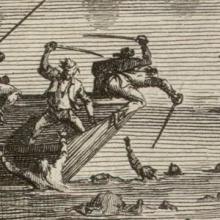
Drowning in the Loire by Order of the Fierce Carrier
On 6–7 December 1793, Jean–Baptiste Carrier, a deputy sent by the Convention to suppress the insurrection at Nantes, accepted, if he did not in fact welcome, a measure proposed by the local Revolutionary Tribunal to fill seven boats with an estimated 200–300 prisoners (not all of them yet convicted) and sink them in the Loire River.

Fusillades at Lyon, Ordered by Collot–D’Herbois
Lyon’s rebellion against the central government in September 1793 had terrible repercussions that seemed only to worsen with the initiation of collective trials and immediate executions by firing squad. The one depicted here on 4 December 1793 took the lives of 935 people, another 732 being guillotined over the next four months.
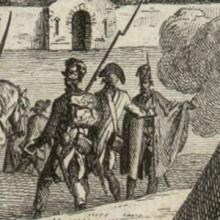
Siege and Taking of the City of Lyon
In September 1793, in response to the unwillingness of the municipal government of Lyon to enforce the legislature’s laws, the Republic sent the deputies and Committee of Public Safety members Georges Couthon and Jean–Marie Collot d’Herbois with a republican army to lay siege to the city and destroy all elements of "counterrevolution." The city surrendered on 9 October.

Summoning to Execution
One of the most fearful parts of the Terror was its unpredictability. Many were swept up in suspicion, including unexpected, even nighttime arrests. As reality and imagination merged, this fear of the uncertainty of the era became an important part of the story, as this print in English testifies.
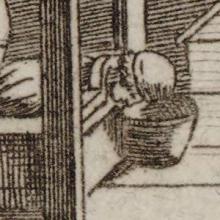
Nine Emigrants Go to the Guillotine
In a woodcut that appeared in Révolutions de Paris, the guillotine is used before a crowd of soldiers and patriotic onlookers, to execute nine "émigrés" who had tried to fell France and thus demonstrated themselves to be traitors.
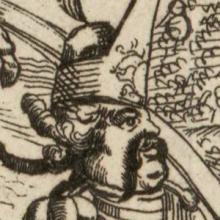
The Counterrevolution
This cartoon mocks all the leading figures of the "Counterrevolution," including the former royal family and its blood relatives, plus the clergy, the nobility, and specific individuals, such as Mirabeau, who had supported the monarchy in the early years of the Revolution.
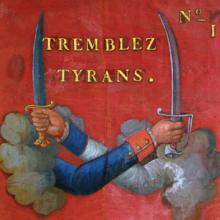
Tyranny Tremble
A very potent image associating France's revolutionary war with an attack on tyrants. Contemporaries would have understood the target, "tyrants," to be the monarchs.
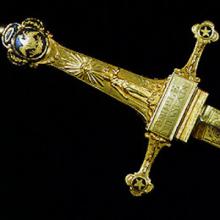
Sword of Sieyès
This ceremonial sword, created for one of the directors in 1799, is presented symbolically as an instrument to defend the "people." Indeed, the war effort was waged for the populace against the perceived injustices of the old regime and its remnants in and outside of France.
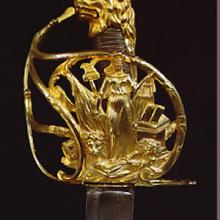
Sword Hilt with Revolutionary Icons—Liberty
This sword, an actual artifact of the revolutionary wars, shows how strongly French officers and soldiers believed themselves to be fighting for the defense of liberty, which is represented by the woman holding the balance and by the Phrygian bonnet on a pike, both visible in the hilt. This example illustrates that even "masculine" objects such as swords depicted liberty as female.
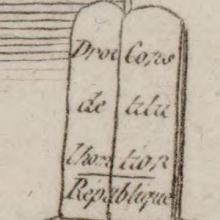
Noble Act of 500,000 Republicans
The revolutionary wars, which would continue in one form or another until Napoleon’s defeat in 1815, were different from other conflicts in early modern Europe. In this struggle that emerged in 1792, both sides thought they were fighting for different ideas of governance and society: political democracy versus traditional hierarchy.
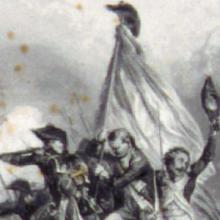
Jemmapes, 6 November 1792
This engraving of the battle of Jemappes, preromantic in its composition and style, depicts a group of French citizen–soldiers bravely risking themselves under the banner of liberty and overcoming all foes in marching to victory—a motif that would become common in the nineteenth century.
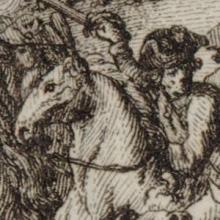
French Victory at the Battle of Jemmappes
This engraving first appeared in the newspaper Révolutions de Paris and shows the French General Charles–François Dumouriez entering the city of Mons after having led French forces to their first truly decisive victory of the war on 6 November 1792.
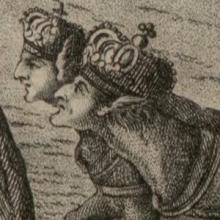
March of the Powers Allied against France
This engraving uses classical figures to depict allegorically an alliance of Prussia, Britain, and Austria, represented as "Tyranny, Hypocrisy, and Pride," who seek to divide the map of France among themselves, while the French Nation prepares to resist so as to bring peace and tranquility to all of Europe.